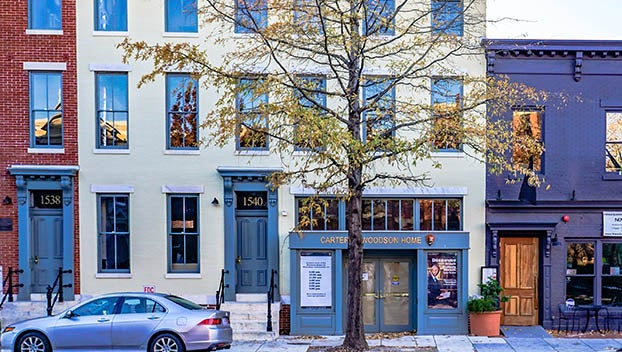Why is the Carter Woodson rowhouse home still closed?
Published 12:17 am Saturday, February 24, 2024

- A look at Woodson’s home, which has been labeled but still not opened to the public. (Photo courtesy of the National Park Service)
|
Getting your Trinity Audio player ready...
|
The home of Carter Woodson, a Buckingham County legend and the founder of what would become Black History Month, still sits idle and empty. This is nine years after the National Park Service (NPS) awarded a management service company a contract to start phase one of construction. A construction project, it’s worth mentioning, that at the time was predicted to take 12-18 months. So why is the home still closed to the public? Officials say there’s still work to do.
Now first, we need to be clear. We are not talking about Mr. Woodson’s birthplace, which is located in New Canton. By this we’re referring to his home in Washington D.C. The three-story brick rowhouse sits at 1538 Ninth Street Northwest in the District, adjacent to two other rowhouses under renovation by NPS. A quick walk down the street reveals a ramen house and cocktail bar, a cannabis-inspired art gallery, and a sushi restaurant: all created and opened to the public long after Woodson’s home was designated a historic landmark in 1976 and bought by the National Park Service in 2005.
A look at the records shows that all of these buildings were purchased, renovated and then opened as their current businesses in much less time than NPS has spent on the Woodson home. While the neighborhood continues to move and bustle, the home where the concept of Black History Month was created remains vacant.
Who was Carter Woodson?
As we mentioned earlier this month, Carter Woodson was born in 1875 in New Canton, Virginia to parents who were formerly enslaved. Woodson spent his childhood in Central Virginia, later moving to Huntington, West Virginia, with his siblings and parents for more employment opportunities. As a young boy, he taught himself how to read and write. Woodson went on to receive a high school diploma, several collegiate degrees, and a Ph.D. in History from Harvard University, the second Black American to receive one from the institution after W.E.B. DuBois.
As Carter Woodson continued his career as an educator, he noticed a lack of information and education pertaining to Black history and life. He was also barred from attending American Historical Association conferences. In 1915, Woodson founded the Association for the Study of Negro Life and History, now known as the association for the Study of African American Life and History, Inc. (ASALH), as a way to illuminate and recognize the achievements, culture, and history of Black Americans that were largely neglected and ignored in his industry.
“If a race has no history, if it has no worthwhile tradition, it becomes a negligible factor in the thought of the world, and it stands in danger of being exterminated,” Woodson said.
The Ninth Street home
The legendary Ninth Street rowhouse was purchased by Woodson in 1922 for $8,000. His living space, office, library, and the ASNLH headquarters were located within the rowhouse. Black artists and leaders spent much time in the home receiving Woodson’s guidance and mentorship. Mary McCleod Bethune, Langston Hughes, and more were regulars. It was within the three-story brick rowhouse that Woodson first came up with the idea of Negro History Week.
Woodson launched Negro History Week in 1926 to coincide with Frederick Douglas and Abraham Lincoln’s birthdays. Woodson died in his home in 1950. Twenty-six years later, his concept was expanded into Black History Month.
The 150-year-old house was in disrepair long before NPS purchased it. In 2015, they awarded a $5.6 million contract to Perini Management Services for renovation.
“This is a major step in opening Dr. Woodson’s home for people to visit,” former superintendent Gopaul Noojibail said that year. “The National Park Service is committed to sharing our nation’s history, and restoring, preserving and opening his home will help people learn about and honor Dr. Woodson’s work and legacy.”
Nine years later, much work still needs to be done.
The timeline has been extended
“The rehabilitation of the Carter G. Woodson Home National Historic Site is actively underway. The project timeline has been extended due to additional work needed to rehabilitate the 150-year-old home,” said National Park Service Public Affairs Specialist Chelsea Sullivan.
Perini Management’s website details phase one of the project and says their contract was complete in 2017.
“Both the interior and exterior of the Carter Woodson townhouse were completely renovated, taking care to remove and restore as much of the original historic finishes (brick, cornices, windows, doors, etc.) as possible,” reads the project description. “The other two townhouse interiors will be restored by NPS at a later date.”
According to the NPS website, the first phase of the project, including repairs of the house facade, permanent stabilization of the home, and reconstruction of several rear walls is complete.
“We are working expeditiously, but we want to preserve as much of the historic fabric as possible. This is a complicated restoration, and we don’t always know what we’re going to find as we go through,” said NPS.
The Woodson home is still closed to the public. The National Park Service said it expects to welcome visitors to the home next winter.
The Shaw neighborhood in Washington, which still embodies the thriving Black cultural history of Woodson’s time, is now home to spots that pique the interest of hip millennials and Gen Z’ers, like beer gardens, coffee shops, and yoga studios.
“Real education means to inspire people to live more abundantly, to learn to begin with life as they find it and make it better,” said Woodson in 1933.
Quietly tucked and still standing in between the trendsetting shops of the new millennium is 1538 Ninth Street, waiting to open its doors and continue to educate and inspire a new generation once again.





